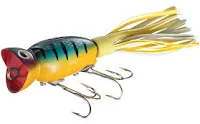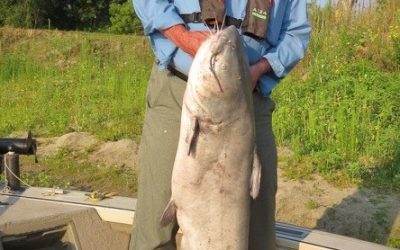There’s a modern day ice fishing revolution going on right now. Vastly improved tackle, lures, ice houses, electronics, underwater cameras and new techniques are just part of the remake of this old sport. And the man responsible for much of it is Dave Genz, pictured here with a lunker blueGILL
As I sit here writing this, the temperature outdoors is pushing 70 degrees. It is Nov. 5.
If you are an ice-a-holic, as I am, you too must be wondering, “Will our lakes and ponds ever freeze over this year?”
The answer, of course, is “Yes, they will.” And it may happen sooner than you think. Time just seems to rush by any more.
With this unseasonably warm weather on hand, it is a great time to begin getting your ice fishing gear in order. As much as we like ice fishing and the cold that comes with it, firing up your auger and inspecting your ice fishing shelter is better done when the outdoor temperature is 60 degrees not 15.
Let’s check our auger first.
There are three areas that need immediate attention. The first is gasoline. It’s best to dump out last year’s supply and start with fresh. Add the right amount of oil to the gas if it is required. Old gas is one of the things that make augers start hard. The other is the spark plug. Pull out and inspect it. Clean it a bit with steel wool or even a small file. Use a feeler gage to set the correct gap. You may not need to replace your spark plug every year, but that also depends a lot on how hard you use it. A lot of guys carry a spare plug and a wrench with them out on the ice. Spark plugs on small engines can get fouled easily and a fresh plug can save a lot of starter rope pulling.
Next, inspect the cutters. If they are dull, replace them. If your ice chips resemble those found in a snow cone, it is time for new cutters.
Finally, start the auger a few times and let it idle. If it starts easily, it is ready for action. If not, take it to a small engine repair center.
Most of us fish out of a portable canvas shelter of one kind or another. Take it out on the lawn and set it up. Make sure mice have not nested in it and chewed holes in the canvas. If so, repair the holes or tears. You may need to clean it out and inspect the moving parts to make sure everything is operating correctly.
When your ice fishing shack is up to specs, take a look at your heater. Most run on propane. Start them up a time or two and let them run for a while. Make sure you have enough propane tanks on hand.
Most of us carry a Vexilar flasher depth finder. Charge the battery or replace if needed and make sure the unit runs correctly.
Rods and reels will need to be inspected and checked. Replace the line if it is mono. I repeat, replace the line. It’s that important. Old mono will retain the memory of the spool and come off the reel looking like a slinky. It is impossible to fish effectively with such line, especially with light lures. I like Berkely Micro Ice in four pound test for panfish and six pound for walleyes. Remember that you do not need to replace all the line on the reel. Peel off about 75 feet and cut. Attach the new line to the old with a barrel knot.
Check the line guides on your rods to make sure they are not broken or pulled loose. Check the reel seats for tightness or apply electrician’s tape to anchor your reel. Make sure the rod is still intact. I’ve found splintered tips on several ice fishing rods in the past. Better to find that now than out on the ice.
Sort through all of your ice fishing lures and clean them if needed or sharpen the hooks if needed.
Inspect your plastics and discard any that have become discolored or sticky.
If you use glow baits, check your flashlights and the batteries.
Also checkout what I call utility items such as your depth bombs, pliers, line clipper and forceps for hook removal. Mine are strung on a cord which attaches to my ice bucket. The depth bombs are clipped onto the wire handle of the bucket.
There’s lots of new stuff on hand this year. Run down to your local sporting goods store and stock up. Tungsten jigs are hot, so too, are tiny plastics to impale on them.
It’s also a good idea to make a check of your ice fishing clothing. I’m a strong believer in layering. I start with polypropylene long underwear top and bottom. Polypropylene wicks any body moisture away and keeps you warmer. I even wear polypropylene socks under my Merino wool ice fishing socks.
I love a lightweight turtle neck shirt over my underwear tops. Turtle necks are almost impossible to find now for some reason. The design keeps your neck warm in all but the coldest weather. If you don’t have a turtleneck, make sure you have a good gaiter to protect your neck from the cold.
If it’s really cold, I might put on a pair of wool or polar fleece underwear over the polypropylene.
My shirt is wool in real cold weather or heavy flannel.
I wear a pair of jeans over the underwear with a waist size a couple inches larger than normal to accommodate the layers. I’ve also taken to wearing suspenders rather than a tight belt and it is much more comfortable.
I’ll probably put on a hooded sweatshirt. If it’s not real cold I’ll just put on some sort of windbreaker over it. My cap will be a regular baseball cap unless we’re talking real cold and then I go with a heavy cap and ear flaps.
Most of the time I wear a set of bibs and parka which are waterproof. You will often kneel in snow or wet ice so the bibs should be waterproof. Some also come with padded knees which are real handy if you fish out in the open.
Not many people think about wearing life jackets when ice fishing, but you should, especially on early ice. Find a model that will fit comfortably over your heavy clothes. My bibs and parka are floaters. Thankfully I’ve never had to find out if they work. At any rate, I’ll wear an inflatable life jacket in addition, just in case.
All ice fishermen should carry a rope with them on the ice. I’ll describe a good survival rope which you can easily make. Get 50 feet of 3/8-inch poly rope. Poly rope floats. Carry it in a nylon bag with a grommet in the bottom through which you thread the rope and tie a knot. Tie a loop in the other end.
If someone falls through, slip the loop over one hand and throw the bag to the victim.
When I’m fishing in the open, I usually sit on a bucket. For safety and comfort, I carry a boat cushion to sit on. It could save me if I fell through or could be thrown to another person if needed.
It won’t stay warm forever. If you have prepared properly, you’ll be ready when first safe ice forms.






0 Comments